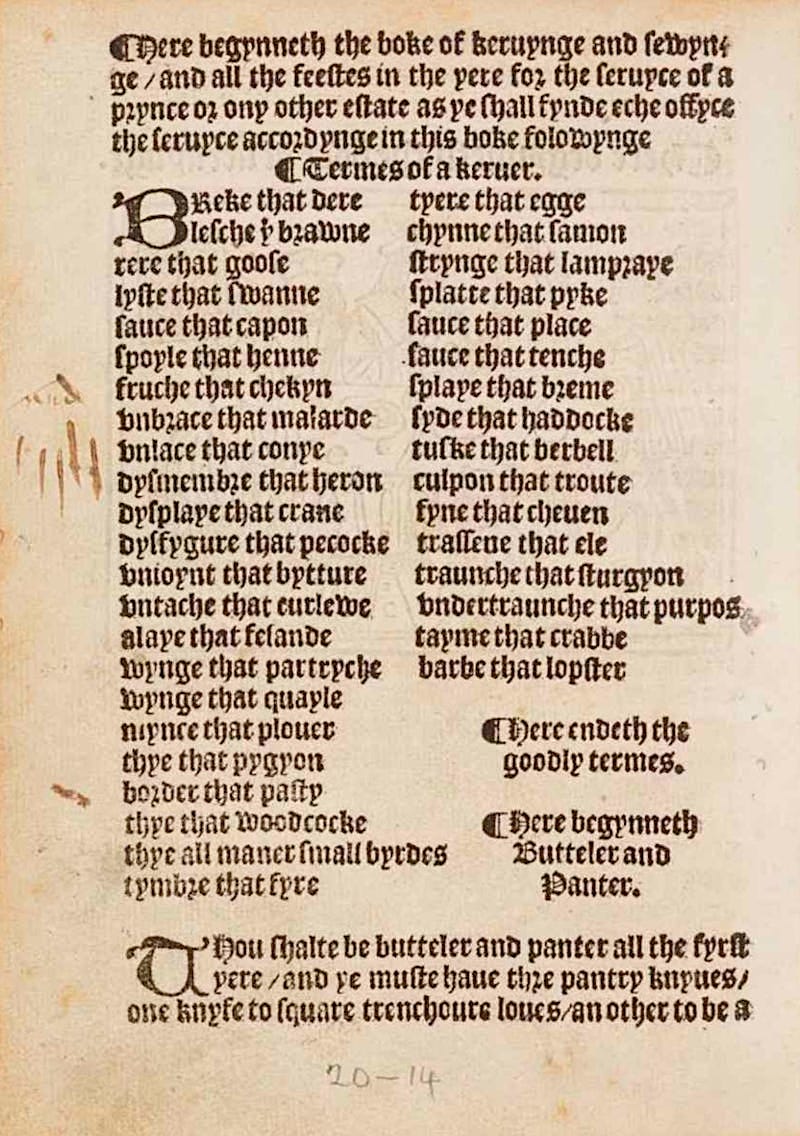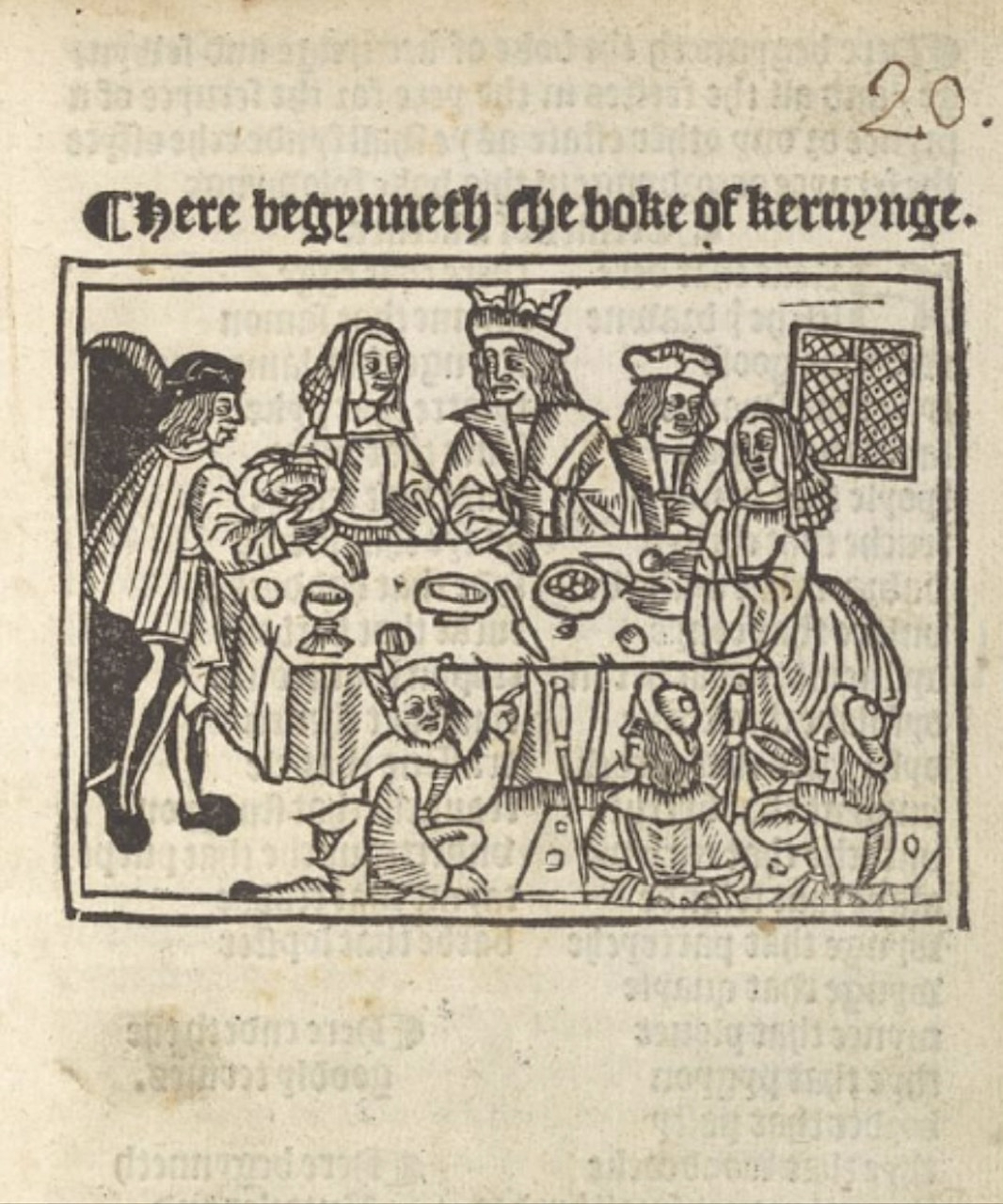
A lesser advertised joy of working in food service is achieving command of the slang:
Monkey dish…
Deuces and four tops…
Fire, flash, kill…
As you may have noticed, we here at Open Culture have an insatiable hunger for vintage lingo and it doesn’t get much more vintage than The Boke of Kervynge (The Book of Carving).
This 1508 manual was published for the benefit of young noblemen who’d been placed in affluent households, to learn the ropes of high society by serving the sovereigns.
Few families could afford to serve meat, let alone whole animals, so understandably, the presentation and carving of these precious entrees was not a thing to be undertaken lightly.
The influential London-based publisher Wynkyn de Worde compiled step-by-step instructions for getting different types of meat, game and fish from kitchen to plate, as well as what to serve on seasonal menus and special occasions like Easter and the Feast of St. John the Baptist.
The book opens with the list of “goodly termes” above, essential vocab for any young man eager to prove his skills around the carcass of a deer, goose, or lobster.
There’s nothing here for vegetarians, obviously. And some 21st-century carnivores may find themselves blanching a bit at the thought of tearing into a heron or porpoise.
If, however, you’re a medieval lad tasked with “disfiguring” a peacock, closely observed by an entire dining table of la crème de la crème, The Boke of Kervynge is a lifesaver.
(It also contains some invaluable tips for meeting expectations should you find yourself in the position of chaumberlayne, Marshall or usher.)

In any event, let’s spice up our vocabulary while rescuing some aged culinary terms from obscurity.
Don’t be surprised if they work their way into an episode of The Bear next season, though you should also feel free to use them metaphorically.
And don’t lose heart if some of the terms are a bit befuddling to modern ears. Lists of Note’s Shaun Usher has taken a stab at truffling up some modern translations for a few of the less familiar sounding words, wisely refraining from hazarding a guess as to the meaning of “fruche that chekyn”.
(It’s not the “chekyn” part giving us pause…)
Termes of a keruer —Terms of a carver
Breke that dere — break that deer
lesche y brawne — leach the brawn
rere that goose — rear that goose
lyft that swanne — lift that swan
sauce that capon — sauce that capon
spoyle that henne — spoil that hen
fruche that chekyn — ? that chicken
vnbrace that malarde — unbrace that mallard
vnlace that cony — unlace that coney
dysmembre that heron — dismember that heron
dysplaye that crane — display that crane
dysfygure that pecocke —disfigure that peacock
vnioynt that bytture — unjoint that bittern
vntache that curlewe — untack that curlew
alaye that fesande — allay that pheasant
wynge that partryche — wing that partridge
wynge that quayle — wing that quail
mynce that plouer — mince that plover
thye that pegyon — thigh that pigeon
border that pasty — border that pasty
thye all maner of small byrdes — thigh all manner of small birds
tymbre that fyre — timber that fire
tyere that egge — tear that egg
chyne that samon — chine that salmon
strynge that lampraye — string that lamprey
splatte that pyke — splat that pike
sauce that playce — sauce that plaice
sauce that tenche — sauce that tench
splaye that breme — splay that bream
syde that haddocke — side that haddock
tuske that barbell — tusk that barbel
culpon that troute — culpon that trout
fynne that cheuen — fin that cheven
trassene that ele — ? that eel
traunche that sturgyon — tranche that sturgeon
vndertraunche yt purpos — undertranch that porpoise
tayme that crabbe — tame that crab
barbe that lopster — barb that lobster
Here endeth the goodly termes.
Peruse a digital copy of the sole surviving copy of the first edition of the Boke of Kervynge here.
Via Lists of Note
Related Content
What Did People Eat in Medieval Times? A Video Series and New Cookbook Explain
A List of 1,065 Medieval Dog Names: Nosewise, Garlik, Havegoodday & More
Ernest Hemingway’s Favorite Hamburger Recipe
– Ayun Halliday is the Chief Primatologist of the East Village Inky zine and author, most recently, of Creative, Not Famous: The Small Potato Manifesto and Creative, Not Famous Activity Book. Follow her @AyunHalliday.
0 Commentaires